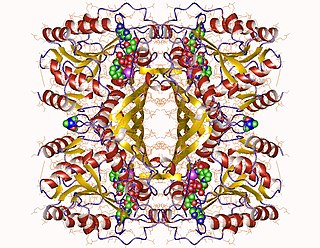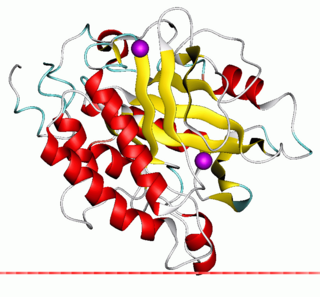Related Research Articles

Inositol, or more precisely myo-inositol, is a carbocyclic sugar that is abundant in the brain and other mammalian tissues; it mediates cell signal transduction in response to a variety of hormones, neurotransmitters, and growth factors and participates in osmoregulation.

Phytic acid is a six-fold dihydrogenphosphate ester of inositol, also called inositol hexakisphosphate (IP6) or inositol polyphosphate. At physiological pH, the phosphates are partially ionized, resulting in the phytate anion.

A phytase is any type of phosphatase enzyme that catalyzes the hydrolysis of phytic acid – an indigestible, organic form of phosphorus that is found in many plant tissues, especially in grains and oil seeds – and releases a usable form of inorganic phosphorus. While phytases have been found to occur in animals, plants, fungi and bacteria, phytases have been most commonly detected and characterized from fungi.

In enzymology, an inositol-3-phosphate synthase is an enzyme that catalyzes the chemical reaction

The enzyme phosphatidylinositol diacylglycerol-lyase catalyzes the following reaction:
The enzyme 4-phytase (EC 3.1.3.26) catalyzes the following reaction:
The enzyme 5-phytase (EC 3.1.3.72) catalyzes the reaction
The enzyme inositol-1,4-bisphosphate 1-phosphatase (EC 3.1.3.57) catalyzes the reaction

The enzyme Inositol phosphate-phosphatase is of the phosphodiesterase family of enzymes. It is involved in the phosphophatidylinositol signaling pathway, which affects a wide array of cell functions, including but not limited to, cell growth, apoptosis, secretion, and information processing. Inhibition of inositol monophosphatase may be key in the action of lithium in treating bipolar disorder, specifically manic depression.
The enzyme multiple inositol-polyphosphate phosphatase (EC 3.1.3.62) catalyzes the reaction
The enzyme phosphatidylinositol-3,4,5-trisphosphate 3-phosphatase (EC 3.1.3.67) catalyzes the chemical reaction
The enzyme phosphatidylinositol-3,4-bisphosphate 4-phosphatase (EC 3.1.3.66) that catalyzes the reaction
The enzyme phosphatidylinositol-3-phosphatase (EC 3.1.3.64) catalyzes the reaction
The enzyme phosphoinositide 5-phosphatase (EC 3.1.3.36) catalyzes the reaction
In enzymology, an inositol-pentakisphosphate 2-kinase is an enzyme that catalyzes the chemical reaction
In enzymology, an inositol-tetrakisphosphate 1-kinase is an enzyme that catalyzes the chemical reaction
Bisphosphate may refer to:
Inositol-hexakisphosphate kinase is an enzyme with systematic name ATP:1D-myo-inositol-hexakisphosphate 5-phosphotransferase. This enzyme catalyses the following chemical reaction
The enzyme Inositol-polyphosphate 5-phosphatase (EC 3.1.3.56, systematic name 1D-myo-inositol-1,4,5-trisphosphate 5-phosphohydrolase; other names type I inositol-polyphosphate phosphatase, inositol trisphosphate phosphomonoesterase, InsP3/Ins(1,3,4,5)P4 5-phosphatase, inosine triphosphatase, D-myo-inositol 1,4,5-triphosphate 5-phosphatase, D-myo-inositol 1,4,5-trisphosphate 5-phosphatase, L-myo-inositol 1,4,5-trisphosphate-monoesterase, inositol phosphate 5-phosphomonoesterase, inositol-1,4,5-trisphosphate/1,3,4,5-tetrakisphosphate 5-phosphatase, Ins(1,4,5)P3 5-phosphataseD-myo-inositol(1,4,5)/(1,3,4,5)-polyphosphate 5-phosphatase, inositol 1,4,5-trisphosphate phosphatase, inositol polyphosphate-5-phosphatase, myo-inositol-1,4,5-trisphosphate 5-phosphatase, inositol-1,4,5-trisphosphate 5-phosphatase) catalyses the following reaction

β-propeller phytases (BPPs) are a group of enzymes (i.e. protein superfamily) with a round beta-propeller structure. BPPs are phytases, which means that they are able to remove (hydrolyze) phosphate groups from phytic acid and its phytate salts. Hydrolysis happens stepwise and usually ends in myo-inositol triphosphate product which has three phosphate groups still bound to it. The actual substrate of BPPs is calcium phytate and in order to hydrolyze it, BPPs must have Ca2+ ions bound to themselves. BPPs are the most widely found phytase superfamily in the environment and they are thought to have a major role in phytate-phosphorus cycling in soil and water. As their alternative name alkaline phytase suggests, BPPs work best in basic (or neutral) environment. Their pH optima is 6–9, which is unique among the phytases.
References
- 1 2 "ENZYME entry 3.1.3.8". enzyme.expasy.org. Retrieved 2018-04-09.
- ↑ Mullaney EJ, Ullah AH (December 2003). "The term phytase comprises several different classes of enzymes". Biochemical and Biophysical Research Communications. 312 (1): 179–84. doi:10.1016/j.bbrc.2003.09.176. PMID 14630039.